The Tip And Tail
If you have ever seen any interviews by world-class sports coaches and trainers, you will have noticed that each coach, in some capacity, provides the same answer to the following question.
What separates the best in the world from the rest?
Their answer? Margins, tiny margins. Simply put, the best are able to do that one percent extra that pushes them into the stratosphere. How this plays into snowboarding is surprising.
Besides the amount of work and time you put into the slopes, the shape of your board profile could be the difference between a stable ride and a disastrous one.
We’ve all got our own unique riding style, and when our gear compliments it, there is nothing to stop us from reaching our full potential. But camber boards come in all kinds of shapes and sizes. There’s more to these board profiles than simple grooves.
Let us break it down for you.
What Exactly is a Camber Snowboard?
Let’s not get ahead of ourselves, before we can even begin to look at the various styles and shapes that camber boards can come in, we’ve got to know what camber snowboards even are.
In fact, allow me to simplify this topic even further by telling you what a camber even is. A camber or camber profile is the shape of your board. It’s not possible to spot your board’s natural shape when looking down at it.
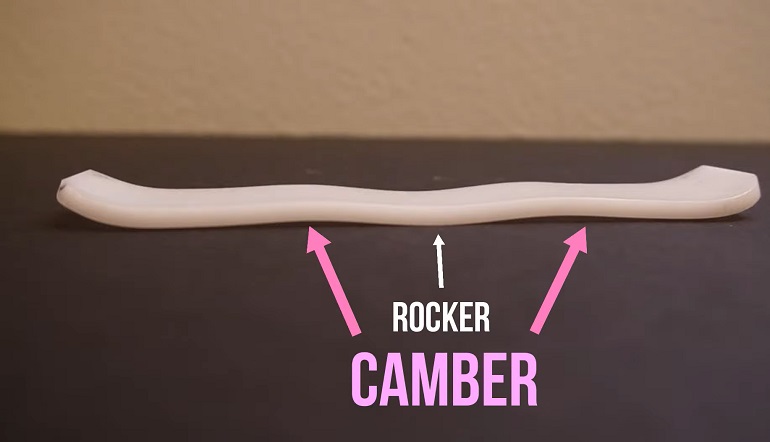
Camber profiles are incredibly subtle. I’d go as far as to say that if you don’t have a solid understanding of what it is that you are looking for, you could have a pronounced camber board and not even know it.
So then, how do you spot a board’s camber profile? You’ve got to set your board down on a flat surface and then look at it from the side. Only from this side view angle will the camber profile be made apparent. Even then, it is still a very subtle thing.
However, we mustn’t discount the importance of margins. Margins are everything.
The camber section of your board comes in a convex shape. In other words, it pops out rather than caves in. Your board has this design in some form, what kind of specific camber board it may be is what we are about to find out.
The Different Snowboard Camber Types
Okay, it seems like we are making serious inroads toward understanding what a snowboard profile is and how to identify it. However, not all camber profiles or camber sections were made equal. Different riding styles benefit more from different camber profiles.
Now’s the time for me to run through all the potential camber profiles that you will come across. I’ll also be going over how they affect the board’s feel and your performance, what certain camber profiles are best for, etc.
Remember, although subtle in design, snowboard profiles have a big impact on how you ride. Even beginner riders should become acquainted with this snowboard feature.
Traditional Camber, Keep it Simple
Earlier I said that not all camber sections are created equal. While this statement is true today, there was one point in time when this was not the case.
Long ago, before flashy marketing names became the only way to differentiate one board from another. All snowboards, or at least the vast majority, used the same kind of camber snowboard profile.
While this camber style is no longer as omnipresent as it once was, it still hangs around.
With this style, a traditional camber runs throughout the entire board! The only areas that don’t have camber underfoot are the tip and tail of the board. The camber stops shortly before reaching said areas.
How does this affect performance? What are traditional camber boards good for? Boards with a traditional camber are much easier to get off the snow and into the air than other camber types.
It’s funny, you’d think that a traditional camber would favor a more conservative style of riding. This is not the case. Jumps and other kinds of airborne maneuvers become easier to initiate, and even your edge hold gets a serious bite to it.
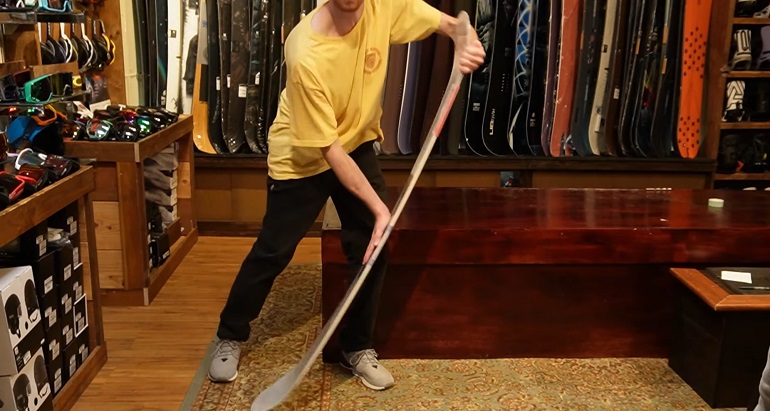
A traditional camber snowboard also allows you to pop out of a turn with greater ease. Essentially, what it boils down to is that jumping becomes your board’s favorite thing to do. Surprisingly, the stability of your ride also improves.
This is due to the fact that the camber underfoot lifts so much of your board. There aren’t as many hard contact points, and so crud and choppy terrain doesn’t bump you around as much.
With this many benefits, it’s understandable why snowboard manufacturers didn’t deviate from the design for so long.
Hybrid Camber, An Evolution
Hybrid camber profiles are an amalgamation of various different snowboard profile styles. This kind of profile was created because manufacturers wanted to take the benefits of a flat, camber, and rocker board and mix them into a true one-board quiver.
These kinds of snowboard camber types are much harder to quantify because there are so many different combinations. To spare my fingers and your time, I’ll be describing what this style is in general rather than running through every possible configuration.
A hybrid camber has a rocker section on either side of the camber. The camber rests at the dead center of the board. The immediate effect of this style of board shape is that your turn initiation will experience a significant boost.
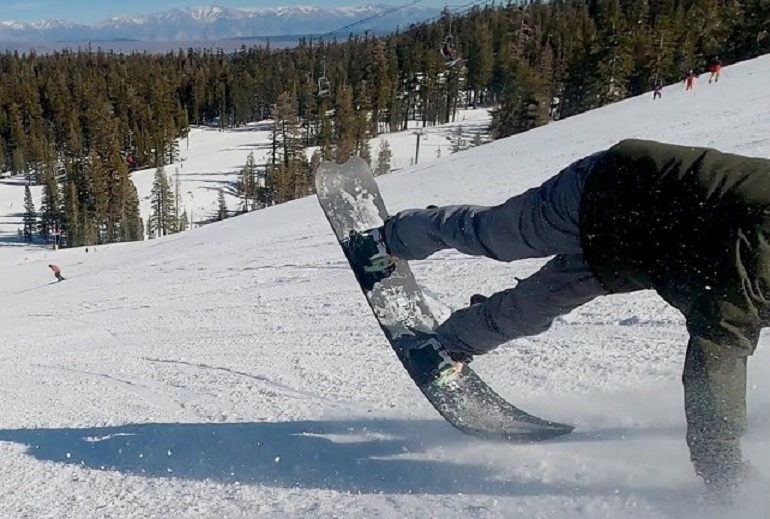
I’m not kidding around, once you have spent a good portion of time with different camber boards, it becomes apparent that initiating a turn with a hybrid camber profile is a whole lot smoother and easier than with other board types.
When riding through fresh pow, the float that comes from the rocker sections also feels fantastic. The liveliness of the rocker sections is complimented well by the stability provided by the camber.
As stated before, a camber brings with it pop and a damper ride however, in this particular configuration, a camber also increases the speed of your board. This is why most freeride boards have a hybrid camber profile.
Keep in mind, that the amount of rocker and camber will vary per board. As well as how pronounced the rocker or camber is. Obviously, this affects the board’s feel.
Continuous Rocker, Continuous Fun
The continuous rocker goes by other names, most commonly known as reverse camber. Reverse camber boards aren’t as complex and varied in their design as the hybrid camber or hybrid rocker boards, but they are a significant deviation from our previous two camber profiles.
What a reverse camber boils down to is the complete reverse of a traditional camber. Where the traditional camber ran through the entire board like a highway, lifting everything in sight toward the sky, a continuous rocker does the exact opposite.
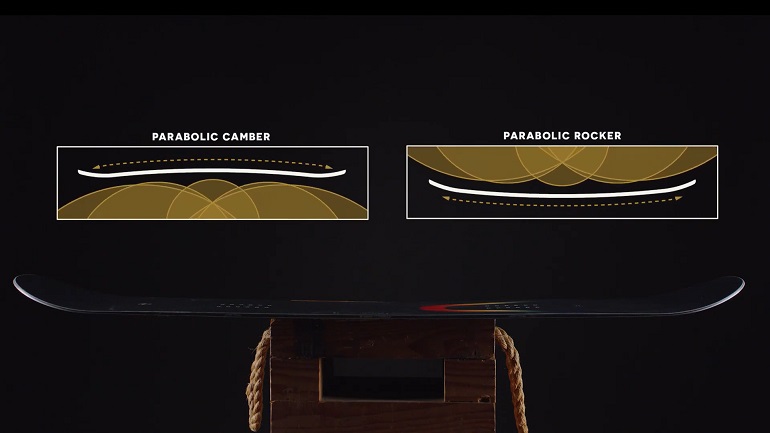
Opting instead to sink all but the tip and tail of the snowboard down into itself. What could possibly come of this? Well, initiating a turn with a continuous rocker is a lot easier than with other board profiles. But most importantly, it becomes a lot harder to catch an edge when you have a reverse camber.
Sounds great, but what’s the catch? You are less likely to catch an edge, but it also becomes less likely for you to catch some air. These boards have a weaker edge hold, and they don’t pop as much as other alternatives. Essentially, the whole board has a looser feel to it.
Why would any experienced rider want this style of snowboard when it seems that traditional camber boards and hybrid profiles are a lot more dynamic? That’s the thing, as I will explain further in the next section, this kind of board is best suited for beginners.
It’s not all bad, these boards are playful, and they float in deep powder quite well.
Flat Camber Snowboards, Broad Performance
A flat camber? That’s right, opting not to have a camber profile still means that you have a camber profile. Only, it’s a flat profile. I’m sure that I don’t have to spend too much time explaining to you what flat profiles look like.
As the name blatantly tells you, flat profiles mean that your entire board is flat across. There is a bit of lift in the nose and tail of the board but otherwise, you are looking at a beautiful plain canvas.
Everything in between the contact points and most of what lies outside of them is flat. If you want a stable ride at slower speeds, then you can’t go wrong with this board type. All this stability may make this kind of camber profile sound appealing to beginners.

Don’t be misled, beginners shouldn’t be using these kinds of boards without worry. Catching an edge grip is a very real thing, especially if you don’t have the experience to recognize the conditions that lead to this happening.
Other areas of benefit with a flat profile are forgiving landings, even when coming down from some big air, and speedy edge-to-edge transitions. Bobbing and weaving through the pines suddenly becomes more doable with this board shape.
As always, there is a downside. What’s the toll that one must pay to enjoy great landings and a stable ride? Your speed, higher speeds, are no longer attainable and if high speeds are what you live for, then stay away from this camber type.
What Camber Profile Is Best For You?
Our journey through the snowboard camber world continues. We started by defining what a camber and camber board is. Then we moved on to explain what the different kinds of cambers were and their benefits.
Now’s the time to explain what kind of camber type you should be using depending on your own riding style. Take note that your ability level will also play a role when it comes to what camber profile you should be using.
Traditional Camber
Let us start off with the traditional camber boards. These boards are best used by those who love aggressive riding. All-mountain snowboard riders who know their way around the slopes.
Advanced intermediates and above will get the most out of this board profile, and beginners should steer clear due to how easy it is to catch an edge.
Hybrid Camber
Hybrid camber boards are best suited for freestyle snowboards and freeride snowboards. With their speed, pop, and flotation, these boards are suited for intermediates and above who love to rip and tear through the slopes. Once more, beginners should look elsewhere for their board.
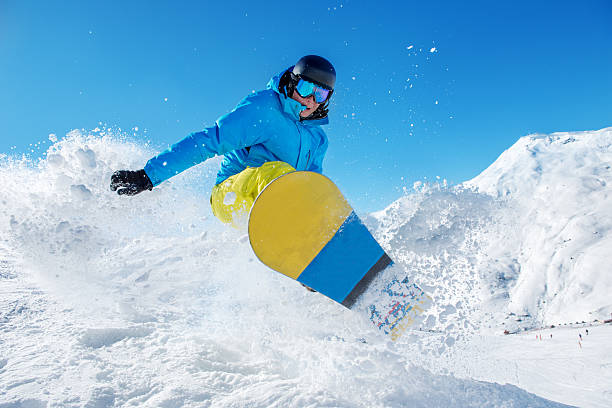
Reverse Camber
Reverse camber boards e definitely a great place to start for beginner snowboard riders. You won’t catch an edge as easily as you do with other board profiles, and popping out of the soft snow and into a bad fall is also more difficult. This is definitely the camber type for those just starting out.
Flat Camber
Finally, we arrive at flat camber boards. A flat camber, rather than a flat-to-rocker profile, is also another great option for beginners. This is due to the stable ride that they provide.
However, catching an effective edge is definitely possible, and so I would rather recommend this camber profile to those that are intermediates but looking to improve.
My Final Thoughts
There you have it, we’ve run the gambit and told you everything that you need to know about cambers. I understand that this subject can get a bit overwhelming, but it is not the be-all-end-all solution for how to choose a snowboard.
If you are a beginner, stick to reverse camber boards, and anyone else can choose the camber profile of their board based on their riding style. Otherwise, you are good to go.
0 Comments